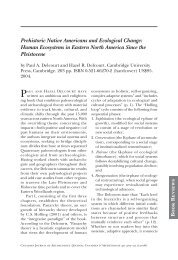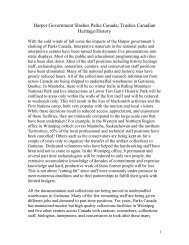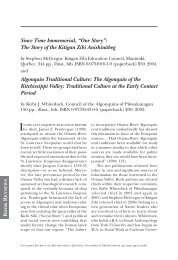ed ochre. What can be said about such sites without visual symbols? In<strong>de</strong>ed some cluesare found in Innu traditions as well as in XVIIIth century’s old maps, but the results of the2011 summer fieldwork offer additional answers and some insights for the betterinterpretation of what appears to be rock art sites without graphic.Aslan, Jasmine Métis Captains’ Coats: Articulating Similarity and Difference (25)Although the establishment of the fur tra<strong>de</strong> in North America is often <strong>de</strong>scribed innegative or <strong>de</strong>structive terms, cultural contact also engen<strong>de</strong>red processes of creation andinvention. From the 16 th century on, indigenous groups assimilated foreign goods andmanufacturing techniques, producing any <strong>number</strong> of ‘hybrid’ artefacts. In this paper, Idiscuss the emergence and evolution of one such class of objects: painted hi<strong>de</strong> captains’coats. Ma<strong>de</strong> according to traditional processes, they nonetheless reflect striking Europeaninfluences in their <strong>de</strong>sign. My discussion of these artifacts hinges on research I conductedinto the ethnohistories of two such garments from the British and Pitt Rivers museums’collections. In the first part of my paper, I consi<strong>de</strong>r mo<strong>de</strong>ls and approaches in the study ofhybrid artifacts, and the ways in which these affected my ethno-archaeological analyses ofthese specimens. In the second, I present my findings; the outcome of my research intotheir ethnohistories.Astudillo, Fernando (University of Calgary), Daniela Balanzátegui, and BarbaraWinter (Simon Fraser University) Collectors, Forgers, and Looters: The History behindAn<strong>de</strong>an Ancient Art (1) The publication of “Inci<strong>de</strong>nts of Travel and Expedition in theLand of the Incas” (Squier 1887), showing drawings of Inca art, created a <strong>de</strong>mand inEurope and North America for “An<strong>de</strong>an antiquities”. As result, collectors and museumsinclu<strong>de</strong>d in their wish list the An<strong>de</strong>an art as an essential piece. The <strong>de</strong>mand created anetwork of looters and artisans that ma<strong>de</strong> replicas often sold as authentic. These replicasare now part of the mo<strong>de</strong>rn museum collections worldwi<strong>de</strong>. The Museum of Archaeologyand Ethnology of Simon Fraser University (Burnaby, B.C), have objects associated withAn<strong>de</strong>an pre-Columbian societies such as Inca, Chimu, Moche, Pasto, Quimbaya, Tumaco-La Tolita, Manteño, and Sican. In the format of a museum temporary exhibit we presentedto the public the probable reasons why the ceramics form part of the collection. Objects ofAn<strong>de</strong>an cultures have special significance for collectors and museums; however, it doesnot mean that they are authentic.Bain 1 , Allison, William Moss 2 , Réginald Auger 1 and Marcel Moussette 1 1 UniversitéLaval, 2 Ville <strong>de</strong> Québec Celebrating 30 years of Teaching and Promoting HistoricalArchaeology in Quebec City (28) In partnership with the Ville <strong>de</strong> Québec and Québec’sMinistry of Culture, Communications and Women’s Condition, Université Laval hasoffered a field school in Historical Archaeology since 1982. In 2012 we will celebratethirty years of training young archaeologists. Over 400 un<strong>de</strong>rgraduate and graduateschools have been trained un<strong>de</strong>r three different field directors. The school has worked atthree major sites in the City: the Intendant’s Palais; Domaine <strong>de</strong> Maizerets and the îlotHunt site, now known as the award-winning Auberge Saint-Antoine. This presentationwill discuss each of these projects and will highlight the importance of consistent trainingand collecting methods, and the key role that long term partnership agreements haveplayed for research and the <strong>de</strong>velopment of theoretical agendas as well as for thepromotion of archaeology within this UNESCO World Heritage City.
Balac, Anne-Marie (Ministère <strong>de</strong> la Culture, <strong>de</strong>s Communications et <strong>de</strong> la Conditionféminine du Québec) et François Bélanger, (Ville <strong>de</strong> Montréal) L’Étu<strong>de</strong> <strong>de</strong> potentielarchéologique <strong>de</strong> l’arrondissement historique et naturel du Mont-Royal, un outil <strong>de</strong>gestion et <strong>de</strong> formation (16) L’étu<strong>de</strong> du potentiel archéologique <strong>de</strong> l’Arrondissementhistorique et naturel du Mont-Royal est un mandat confié à l’Université <strong>de</strong> Montréal parla Ville <strong>de</strong> Montréal et le MCCCFQ. L’étu<strong>de</strong> <strong>de</strong> ce territoire vise les objectifs suivants : laconnaissance, la protection et la mise en valeur <strong>de</strong>s ressources archéologiques, ainsi que laformation. Elle vise à documenter et à reconstituer la séquence d’occupation ; à délimiterles principaux secteurs d’intérêt archéologique et les cartographier à en permettrel’analyse spatiale, synchronique, diachronique et thématique; à i<strong>de</strong>ntifier les ressourcesarchéologiques. En termes <strong>de</strong> protection et <strong>de</strong> mise en valeur, elle vise à élaborer un outil<strong>de</strong> gestion du patrimoine archéologique En termes <strong>de</strong> formation, elle vise à former <strong>de</strong>sétudiants <strong>de</strong> 2 e cycle dans les pratiques <strong>de</strong> la gestion archéologique et à favoriser larecherche sur les ressources archéologiques montréalaises. La présentation mettra l’accentsur l’utilisation pratique <strong>de</strong> l’outil par la Ville, le Ministère et l’Université ainsi que sur lesla méthodologie utilisée pour sa création.Banks 1 , William E., Francesco d'Errico, João Zilhão 1 . Université <strong>de</strong> Bor<strong>de</strong>aux IHuman-climate interaction in the Early Upper Palaeolithic: testing the hypothesis of anadaptive shift between the Proto-Aurignacian and the Early Aurignacian (26) Materialculture changes during the Proto-Aurignacian and the Aurignacian are coinci<strong>de</strong>nt withabrupt and marked climatic changes. We use eco-cultural niche mo<strong>de</strong>ling to quantitativelyevaluate whether shifts in material culture are correlated with environmental variabilityand, if so, whether the ecological niches exploited by human populations shiftedaccordingly. We employ genetic algorithm (GARP) and maximum entropy (Maxent)techniques to estimate the ecological niches exploited by humans (i.e., eco-culturalniches) during these two phases of the Aurignacian. A Partial-ROC analysis is used toevaluate niche variability between the two phases. Results indicate that the changes inmaterial culture between the Proto-Aurignacian and the Early Aurignacian are associatedwith an expansion of the ecological niche exploited during the latter phase. These shifts ineco-cultural niche and material culture are interpreted to represent an adaptive response tothe relative <strong>de</strong>terioration in environmental conditions at the onset of Heinrich Event (HE)4.Beaudoin, Matthew (The University of Western Ontario) Archaeologists ColonizingCanada: The Effects of Unquestioned Categories (3) Many would argue that colonialismis a fundamental aspect of historical archaeology; however, the un<strong>de</strong>rlying meaning ofthis statement is often ignored. In sum, the production of archaeology is part of thecolonial process and is based around a discourse of colonizer norms and colonize<strong>de</strong>nclaves. This has resulted in the unconscious production of an accepted Euro-<strong>Canadian</strong>dominant “historical archaeology” and various “colonial archaeologies” of perceivedminority groups, that accepts the premise of a Euro-<strong>Canadian</strong> normative master narrativepunctuated with alternative discourses of specific groups. In effect, we’ve created twodistinct narratives of historical archaeology that are framed against each other but neverquite coming in contact. By examining multi-generational sites from 19 th -century OntarioI explore the effects this has on the continued discourse, and why we should be bridgingthese disparate narratives.
- Page 1 and 2: RÉSUMÉS / ABSTRACTSPar ordre alph
- Page 3: glyphs in images for posterity have
- Page 8: Bergeron, André (Centre de conserv
- Page 12 and 13: forme traditionnelle imprimée ou d
- Page 14: after learning about what happened
- Page 17 and 18: Cadieux, Nicolas, Jean-Christophe O
- Page 19: known in the area, both historic an
- Page 22 and 23: Comeau, Jennifer (Memorial Universi
- Page 24 and 25: in single households. Given that th
- Page 27 and 28: Crompton, Amanda (Memorial Universi
- Page 29 and 30: describe the spatial extent of the
- Page 31 and 32: Columbia. Although dogs are not a d
- Page 33 and 34: planification des fouilles archéol
- Page 35 and 36: synthèse des données biophysiques
- Page 37 and 38: Ellis, Christopher (University of W
- Page 39 and 40: ever made in an archaeological site
- Page 41 and 42: qui occupait déjà l’esprit des
- Page 43 and 44: impliqués dans les pêcheries et l
- Page 45 and 46: préhispaniques. Parmi ces camélid
- Page 47 and 48: archaeometrists these days is a tec
- Page 49 and 50: patches undertaken to identify the
- Page 51 and 52: integration of feature, artifact an
- Page 53 and 54: l’appellation crie désignant les
- Page 55 and 56:
order to ensure there was no damage
- Page 57 and 58:
in 1851 as a market and destroyed i
- Page 59 and 60:
devait tenir compte des grands prin
- Page 61 and 62:
elusive has been a consistent way o
- Page 63 and 64:
driving forces in Québec archaeolo
- Page 65 and 66:
Ly, Yvonne (Archéotec inc.) Essai
- Page 67 and 68:
contribution de Google Earth à la
- Page 69 and 70:
to its taphonomic agent. These obse
- Page 71 and 72:
Monchot, Hervé (Université Paris
- Page 73 and 74:
horticulturalists. Broad-bladed bif
- Page 75 and 76:
Oetelaar, Gerald (University of Cal
- Page 77 and 78:
Paxton-MacRae, Mark (Western Herita
- Page 79 and 80:
19 th and 20 th centuries. Old-grow
- Page 81 and 82:
while deer, particularly white tail
- Page 83 and 84:
Rankin, Lisa K. (Memorial Universit
- Page 85 and 86:
Robinson IV, Francis (University at
- Page 87 and 88:
Royer, Martin (Ethnoscop inc.) Inve
- Page 89 and 90:
Sifontes, Sarah (York University) D
- Page 91 and 92:
isotopique par spectrométrie de ma
- Page 93 and 94:
quarries have been discovered and e
- Page 95 and 96:
aux XVII e et XVIII e siècles (25)
- Page 97 and 98:
last rapids of St. Laurence river.
- Page 99 and 100:
Woods, Audrey (Université de Montr
- Page 101 and 102:
theorizing material culture, much o








